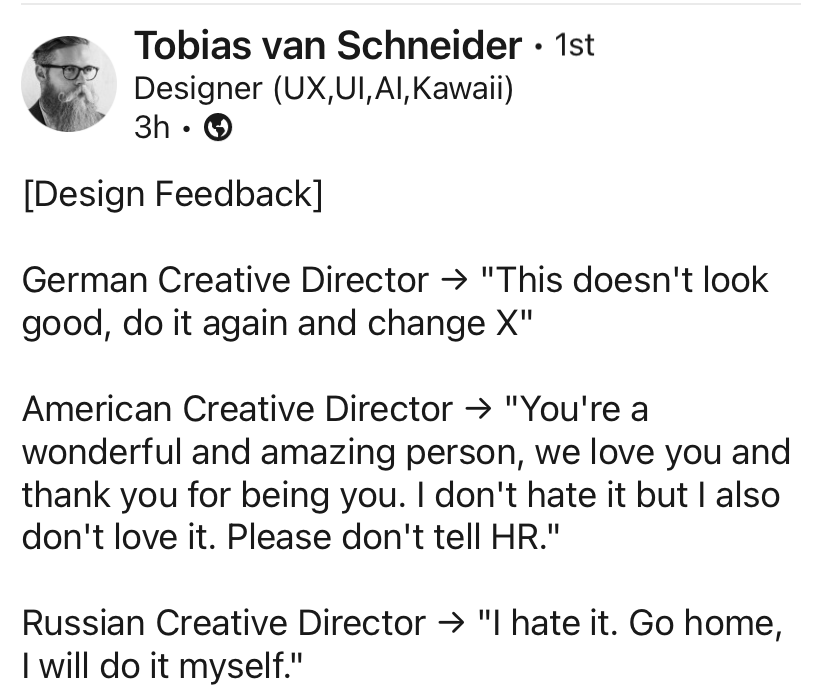Recently, as I study the design industry and do research for my design school, I found myself browsing through online design communities more often.
We are very lucky to have a plethora of communities to choose from these days.
There are many people there who are incredibly supportive, resourceful and wise.
But I found myself feeling uncomfortable more and more while reading through discussion threads.
The reason is — I felt for so many newer designers who are struggling to get a foot in the door or pay the bills if they are already “in the door”.
Most of the time, when I provide feedback or advice for them, I will look at their work to see if there’s anything to worry about there.
Unfortunately, 90% of the time, there is.
My dilemma is — I couldn’t tell them without sounding condescending or offensive.
In fact, most people won’t say anything about their quality of work. Instead, they will provide kind advice about doing a couple of other things, like networking, learning more skills, getting a mentor.
The point of this article is not about how to build your portfolio.
Rather, it is about a few uncomfortable truths that hopefully will help you get unstuck.
I learned these from direct and indirect experience through my decade as a designer working for many different companies and my recent foray into design education.
Your Work Is Okay or Even Good, But There Is No “Wow Factor”
When someone visits your portfolio site, they need to feel one thing in order to proceed with hiring you.
They need to feel the “wow”.
Unfortunately, the majority of the time, many junior designers’ work give off a “it’s fine” vibe.
Unfortunately, the majority of the time, many junior designers’ work give off a “it’s fine” vibe.
As a junior designer, it falls on you to detach yourself from your work and reassess it as if this is done by someone else.
Would you be “wow-ed”? Would your eyes linger to read more?
It requires a good amount of self-awareness, humbleness and curiosity.
When things don’t work out, the first kind of emotion we fall onto is usually frustration, anger and in some cases, despair.
While all of the above-mentioned emotions are valid and natural to us, we need to divert them to assess our own work quality, branding and presentation.
If you cannot answer the question “what is the wow factor of your work” within 30 seconds, you know you have some work to do.
If you cannot answer the question “what is the wow factor of your work” within 30 seconds, you know you have some work to do.
“Wow” Factor Can Come From Many Places
Now that we’ve established that we need a “wow” factor, how do we get it to appear on our work?
It may sound abstract and unattainable for junior designers, but it really isn’t if you pay attention.
The “wow” factor can be customized to your own strengths and personality.
The “wow” factor can be customized to your own strengths and personality.
For example, I recently interviewed Anna Istomina, former UX designer at Apple, for our upcoming video and audio interview series Creative Office Hour by Path Unbound.
In her own words, she didn’t have as much experience as other designers who had fancier degrees and have worked for bigger companies/clients.
She said from her own perspective, her portfolio at the time was okay.
But she got the job at one of the most coveted places to work. How?
Her story certainly blew me away.
When she was asked if she was familiar with Apple’s Human Interface Guidelines, she answered honestly: “No, but give me 3 days. I will.”
Sure enough, she got the job.
That was her wow factor. Her incredible confidence and can-do attitude made her a candidate that was hard to resist.
It didn’t come from a traditional place, but it certainly worked.
Your wow factor may be different from Anna’s.
It may be that you spent extra time at creating incredibly sleek navigation animation for your portfolio website. It may also be that you build a strong personal brand by creating lots of cool content.
It may be that you have a unique combination of skill sets and you made sure to market that.
If you didn’t have them yet, think what you can cultivate.
Don’t stop at — “I can’t seem to find a job or client. The world sucks.”
Complaining doesn’t do anything. Find out how you can make your goal happen and don’t stop trying after the first, second, third, fourth (or even more) defeats.
Success belongs to those who are curious, self aware and persistent.
Success belongs to those who are curious, self aware and persistent.
Look For The “German Creative Director” Type of Mentor
I have never seen someone with amazing work that kept screaming “wow” at me who had trouble finding work.
There may be a few cases with unfortunate circumstances, but the majority of the time, that is rarely the case.
Most of the time, the people who can produce “wow-inducing” work establish their own brand because they are so shiny on their own, it makes more sense for them to be an independent artist/creator/designer.
If you are looking to really make it, find a mentor who can be as brutally honest with you as a “German creator director” type.
Tobias van Schneider is a designer and entrepreneur who I admire.
He posted a humorous comparison among different types of creative directors.

On his LinkedIn post, he said that a German creative director will often be very blunt and direct, pointing out the exact things a junior designer needs to change so that they can accomplish the goal faster.
American creative directors will be very nice and beat around the bush while they give feedback.
On the other hand, Russian creative directors will be even more direct and express their hatred for work that is not there yet.
This is of course a broad generalization for humor.
But the “German creative director” type is the kind of mentor junior designers need.
They may hurt your feelings a little, but what they said is going to help you make significant improvements.
In ancient Chinese idiom, we have a saying: “Extraordinary students come from strict teachers. (严师出高徒.)”
Extraordinary students come from strict teachers.
I actually offer this as a suggestion to a student who recently asked what the best investment is for a junior designer.
No doubt, it is finding that honest mentor who will push you to achieve more than you can imagine.




